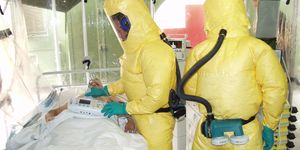Thirdhand Smoke Changes Gene Expression in Human Cells
Burning tobacco products and exhaling smokers release secondhand smoke that can cause health problems in people that aren’t actively smoking. The smoke from burning tobacco products also lingers, and permeates things like furniture, hair, and clothing, creating thirdhand smoke (THS) - the residues of smoking (as explained in the video). New research has shown that THS can damage cells in the nasal cavity. The findings have been reported in JAMA Network Open, and may help clinicians treat those impacted by THS.
"Our data show that cells in humans are affected by thirdhand smoke," said the research leader Prue Talbot, a professor in the Department of Molecular, Cell and Systems Biology at the University of California, Riverside. "The health effects of THS, have been studied in cultured cells and animal models, but this is the first study to show a direct effect of thirdhand smoke on gene expression in humans."
"THS can resurface into the atmosphere and can be inhaled unwillingly by nonsmokers," explained study first author Giovanna Pozuelos, a graduate student in Talbot's lab. "It has not been widely studied, which may explain why no regulations are in place to protect nonsmokers from it."
In this study, a small group of four volunteers was exposed to THS in a laboratory setting for three hours, and the scientists took nasal scrapes afterwards, and harvested RNA from the samples. The procedure was also done on the same participants using purified air; exposures were randomized among the group, with 21 days in between them.
Active genes are transcribed into RNA before cells use that to make protein, so the RNA enabled the researchers to get a snapshot of gene activity and find how it changed after THS exposure. The researchers determined that the expression of 382 genes went up, while seven went down. They also learned what cellular pathways these genes are involved in.
"THS inhalation for only three hours significantly altered gene expression in the nasal epithelium of healthy nonsmokers," Pozuelos said. "The inhalation altered pathways associated with oxidative stress, which can damage DNA, with cancer being a potential long-term outcome. It's extremely unlikely a three-hour exposure to THS would cause cancer, but if someone lived in an apartment or home with THS or drove a car regularly where THS was present, there could be health consequences."
The nasal cell gene expression pattern is similar to what’s seen in the bronchial epithelium, so the researchers hypothesized that this work will also apply to other respiratory cells. The activity of mitochondria, organelles that act as cellular powerhouses, was also negatively impacted by THS.
"Many people do not know what THS is," said Talbot, the director of the UCR Stem Cell Center. "We hope our study raises awareness of this potential health hazard. Many smoking adults think, 'I smoke outside, so my family inside the house will not get exposed.' But smokers carry chemicals like nicotine indoors with their clothes. It's important that people understand that THS is real and potentially harmful."
Sources: AAAS/Eurekalert! via University of California, Riverside, JAMA Network Open









